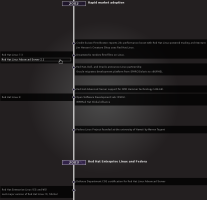Ten years of Red Hat Enterprise Linux

![]() Partial view of the RHEL timeline
Partial view of the RHEL timeline
Source: Red Hat
Red Hat Enterprise Linux (RHEL), probably the most popular product from Linux specialists Red Hat, is now ten years old. To mark this anniversary, the company has released a timeline that lists the most important milestones in the development of Red Hat and RHEL.
Red Hat Linux Advanced Server 2.1 was the first product in the RHEL line; it was released ten years ago, shortly after Red Hat Linux (RHL) 7.3. One-and-a-half years later, RHL 7.3 died and was reborn in Fedora, a community project founded and sponsored by Red Hat that has provided the basis for RHEL ever since.
In a webcast to celebrate the anniversary, Red Hat's President of Products and Technologies, Paul Cormier, explained that making this change was the right thing to do, and that the developers will continue to use the model that has also been adopted for JBoss. Cormier also said that the introduction of the subscription model – established with RHEL and since emulated by many other companies – was the most decisive moment in the history of Red Hat. When asked about mistakes, Cormier said that, when integrating virtualisation technologies in RHEL5, the company should have provided more means to simplify the management of physical and virtual systems.
During the webcast, the Executive Vice President and General Manager of Red Hat's Platform Business Unit, Jim Totton, said that the company plans to release RHEL7 in the second half of 2013. The executive added that the next generation of RHEL will, therefore, become available three years after RHEL6 – and that this is Red Hat's planned cadence for major RHEL releases. Minor updates such as RHEL versions 6.1 and 6.2 will continue to be released every six months. Recently, Red Hat has roughly kept to this frequency and will most likely also keep to it for RHEL 6.3, which is currently being prepared for release. When asked about the integration of OpenStack components in RHEL, Cormier explained that Red Hat is already contributing a lot of code to the cloud platform and will increase its efforts in the future; however, the decision as to which products will include OpenStack components has not yet been made.
The webcast, which gives an overview of many milestones in the history of RHEL, can be accessed after completing a registration form. In March, when the company announced that it had achieved a turnover of more than $1 billion in the previous business year, The H took a look at Red Hat's history.
(fab)
![Kernel Log: Coming in 3.10 (Part 3) [--] Infrastructure](/imgs/43/1/0/4/2/6/7/2/comingin310_4_kicker-4977194bfb0de0d7.png)

![Kernel Log: Coming in 3.10 (Part 3) [--] Infrastructure](/imgs/43/1/0/4/2/3/2/3/comingin310_3_kicker-151cd7b9e9660f05.png)
















